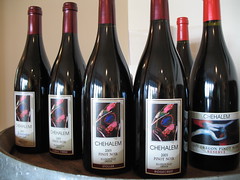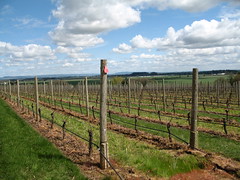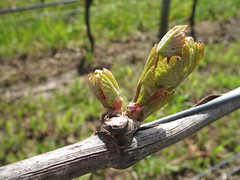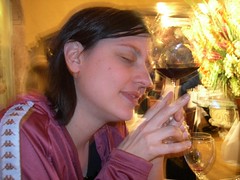Harry Peterson-Nedry of Chehalem
C&D ROAD STATS:
Miles driven: 4876
Winemakers/Viniculturists Interviewed: 25
Wines tasted: 370
Percentage of Jaw-dropping scenery in Willamette Valley: 99%
 The name Harry Peterson-Nedry goes down in the Cork and Demon Hall o' Fame under the category 'Most Willing to Shave Off a Chunk of Time Under Pressure'. He met me over a cup of joe on his way to a very important-sounding meeting in Portland, yet never appeared rushed or annoyed, and even stayed into the time I estimated it would take him to get to downtown. What a champ.
The name Harry Peterson-Nedry goes down in the Cork and Demon Hall o' Fame under the category 'Most Willing to Shave Off a Chunk of Time Under Pressure'. He met me over a cup of joe on his way to a very important-sounding meeting in Portland, yet never appeared rushed or annoyed, and even stayed into the time I estimated it would take him to get to downtown. What a champ.
What follows is my longest, geekiest interview ever. If you count yourself as a Pinot dork, this will satisfy. If not, get in touch with your inner wine geek and read on.
Interview with Harry Peterson-Nedry, Chehalem Wines
C&D: (into recorder) This is Harry Peterson-Nedry....
Harry: Kind of a weird name...
Not at all. But do people have to call you 'Mr. Peterson-Nedry, sir'?
Whoever does that...only talks to me once (laughs). Always Harry.
So, give me the nutshell version of how you got started.
I got started being impassioned about wine. I also grew up on a farm in the Southeast, and got a couple of degrees. A degree in chemistry. And that allowed me to earn some dollars but it also gave me the wherewithal when I became so impassioned and found myself in Oregon, that I wanted to go out and find vineyard land and begin a winery...this is the late '70's. It also gave me the wherewithal to actually implement, so an (agricultural) background, and chemistry degree, and a love of wine were basically my undoing. I'd come to the Northwest as an interlude between industry stints. I worked for a large corporation as a chemist, and I was somewhat disenchanted with it, after a couple of years, because of the 'big business' aspect of it, and people were just as petty as adults as they were as children.
Imagine that.
Yeah, and I was naiive at the time. I took a time off, and during that interlude I was writing, one of my other degrees was in English, and I chose the Northwest to come to write. So I was in a mountain cabin for about a year, wasting away my savings account, and when that ran out, I stayed here and went back to the industrial, technical roles. That was in the '70's, and that's when I realized the (wine) industry was going to be important, and I was going to be a part of it.
What was the Willamette Valley like in the '70's?
It was...1966 was when the first grapes were planted by Dave Lett of Eyrie Vineyards, and by the time--say '79--when we started looking for lands, I think there were only twenty-some wineries and there were, maybe...1200 acres of grapes, total? Something like that. Reisling, at that time, was a conversion for people from soda pop to wine, made in a very innocuous, crappy style, and was 23% of everything Oregon did. Right now, it is down to 3%. Pinot Gris had just barely been planted, there were less than 100 acres of it planted in 1980 when we began. We chose to plant in the first two years of our planting two clones of Pinot Noir, Pinot Gris, Chardonnay and Gamay Noir. Pinot Gris, we followed in the vision of David Lett on that, and that was a very smart choice.
What's your personal philosophy about Pinot Noir? When did you become interested in it, and what was it about the variety that you liked?
Wine in general--and Pinot Noir is the ultimate reflection of it--is complex, it's intellectual, it's always different depending on where it's grown, and so it's ability to reflect terroir is critical. And it also ages magnificently, which is not to say that it'll live for a hundred years, but is to say that it will gain much in character as it goes through it's ageing process. And I think compared to the Bordelais varieties, Pinot Noir is great because, pretty much straight out of the chute, was bottle shock is over after bottling, it's ultimately very drinkable, and what you get out of a brand new fresh Pinot Noir is very rewarding, but very different from the wine that you'll get as it gradually ages. That's appealing.
That must be interesting from a chemistry point of view as well.
Oh, it is. We actually do a lot of nerd stuff as far as the chemistry of wines as they age, and also as we treat them with different variables. Pinot Noir is so hard to grow and hard to make that it gave me the opportunity to use some tools that I was working with in industry at the time. When you're making exotic metal engine components, you wouldn't think there was any connection, but we were trying to get that industry into statistically designed experiments, where you can tell a lot about what drives mechanisms and how you can improve things. And I used those sort of tools when learning about Pinot Noir.
 Since I've been traveling, I've been trying to get my head around the different styles of Pinot Noir from Santa Barbara County to here. Some of them forward and big, others leaner. What are your thoughts on style?
Since I've been traveling, I've been trying to get my head around the different styles of Pinot Noir from Santa Barbara County to here. Some of them forward and big, others leaner. What are your thoughts on style?
The style that I prefer is one that reflects fruit, but is not all fruit. That has structure, and the structure's largely acid, but with a certain amount of fine tannin. We embrace in winemaking a certain amount of native fermentation, whole cluster in part, but not exclusively. We also harvest fully ripe, which is not to say that it's overripe, but we're somewhat anal about when we pick. It's a matter of one or two days, and tasting through vineyards to know exactly, physiologically we should be picking.
Sounds like you actually use your senses rather than "okay, we're at 24 brix, 25 brix..."
That's very astute, and it was also one of the most difficult things for me to learn...when to pick. I had to unlearn...not unlearn my chemistry but to set it aside; instrumental methods weren't going to tell me how to make great Pinot Noir. For example, a Pinot Noir berry, you can look at in a cluster and tell how close it is to the ultimate ripeness. If you shake a fully ripe cluster of Pinot, a third of the berries should fall off. They shouldn't be photogenic, they should be dusty and, "Oh my God, are these things over the hill?" like a basketball you've left in the closet for six months. That's Pinot Noir at it's ultimate ripeness.
Talk a little about terroir in the Willamette and Pinot Noir.
 Pinot Noir is the most reflective variety of terroir. It reflects the site differences, I think, more than any other varietal in the red spectrum. Reisling is that for the white spectrum. Terroir is critical in a place like Burgundy and critical in a place like Oregon. We have different soils, different folding of land masses, sheltering...the geographies give you different climatic conditions, the soils are very diverse. When people think of the Willamette valley they think of very rich growing conditions here and they're thinking of bottom land. Of course, everything in Oregon is on hillsides. What we get is not a consistent bottom land of topsoil that was brought in from Idaho, Montana and Washington millions of years ago, what we get are some of the uplifts of ocean sediment, sediment blown in from later times, we get a lot of volcanic material, up to 25 different strata. So the complexity of the terroir is almost mind-boggling.
Pinot Noir is the most reflective variety of terroir. It reflects the site differences, I think, more than any other varietal in the red spectrum. Reisling is that for the white spectrum. Terroir is critical in a place like Burgundy and critical in a place like Oregon. We have different soils, different folding of land masses, sheltering...the geographies give you different climatic conditions, the soils are very diverse. When people think of the Willamette valley they think of very rich growing conditions here and they're thinking of bottom land. Of course, everything in Oregon is on hillsides. What we get is not a consistent bottom land of topsoil that was brought in from Idaho, Montana and Washington millions of years ago, what we get are some of the uplifts of ocean sediment, sediment blown in from later times, we get a lot of volcanic material, up to 25 different strata. So the complexity of the terroir is almost mind-boggling.
There are those that would argue that this whole AVA and sub-appellation designation and the terroir of this particular vineyard are all about marketing. What do you say to them?
The main things in order that affect Pinot Noir are gross climate, the terroir, the vintage, and the winemaker. And the fingerprint of the winemaker can be pretty significant. At the same time, all you have to do is have the same winemaker using the same techniques...and make it from different sites. We have three sites with radically different terroir, and we make Pinot Noir very consistently, and we come out with radically different wines.
After the interview, I made arrangements to meet Carolyn at the Chehalem tasting room to check out the vino. The Pinots were all very big and hi-octane, being from the scorcher 2003 vintage; a couple of 'em weighed in at a whopping 15.5% alcohol. Damnation, that's high for a Pinot, I thought to my little self. I asked Carolyn about it. "Harry doesn't like to compromise. In a hot vintage, he still wants to pick at grape maturity, not based on ripeness levels. What mother nature does each vintage is out of our hands."
Maturity, I'm learning, is different from ripeness. While ripeness can mean that the sugar levels are at their appropriate level, maturity means that the whole grape--skins, seeds, and all--has fully developed. In a hot vintage, the grapes become fat with sugar, possibly before the seeds and skins have reached maturity. Since alcohol is directly proportionate to the sugar from which it converts, a hot vintage means a boozy-ass wine.
With that in mind, and disregarding my own preferences, these wines were impressive. Each single vineyard Pinot had its own little statement to make, and did so without boozing out on the finish or lacking any nice Pinot secondary flavors. I've found that the single vineyard thing is a big obsession for the Pinot producers in Willamette. Every vineyard is a big pot of another color tempura to play with.
Enough of all this geekfestation....ladies in the house, listen up!...Jim Prosser of JK Carriere is a total hottie, y'all! Oh, and his Pinot Noir is really kickass. Don't miss it!
Clinkies!
Miles driven: 4876
Winemakers/Viniculturists Interviewed: 25
Wines tasted: 370
Percentage of Jaw-dropping scenery in Willamette Valley: 99%
 The name Harry Peterson-Nedry goes down in the Cork and Demon Hall o' Fame under the category 'Most Willing to Shave Off a Chunk of Time Under Pressure'. He met me over a cup of joe on his way to a very important-sounding meeting in Portland, yet never appeared rushed or annoyed, and even stayed into the time I estimated it would take him to get to downtown. What a champ.
The name Harry Peterson-Nedry goes down in the Cork and Demon Hall o' Fame under the category 'Most Willing to Shave Off a Chunk of Time Under Pressure'. He met me over a cup of joe on his way to a very important-sounding meeting in Portland, yet never appeared rushed or annoyed, and even stayed into the time I estimated it would take him to get to downtown. What a champ.What follows is my longest, geekiest interview ever. If you count yourself as a Pinot dork, this will satisfy. If not, get in touch with your inner wine geek and read on.
Interview with Harry Peterson-Nedry, Chehalem Wines
C&D: (into recorder) This is Harry Peterson-Nedry....
Harry: Kind of a weird name...
Not at all. But do people have to call you 'Mr. Peterson-Nedry, sir'?
Whoever does that...only talks to me once (laughs). Always Harry.
So, give me the nutshell version of how you got started.
I got started being impassioned about wine. I also grew up on a farm in the Southeast, and got a couple of degrees. A degree in chemistry. And that allowed me to earn some dollars but it also gave me the wherewithal when I became so impassioned and found myself in Oregon, that I wanted to go out and find vineyard land and begin a winery...this is the late '70's. It also gave me the wherewithal to actually implement, so an (agricultural) background, and chemistry degree, and a love of wine were basically my undoing. I'd come to the Northwest as an interlude between industry stints. I worked for a large corporation as a chemist, and I was somewhat disenchanted with it, after a couple of years, because of the 'big business' aspect of it, and people were just as petty as adults as they were as children.

Imagine that.
Yeah, and I was naiive at the time. I took a time off, and during that interlude I was writing, one of my other degrees was in English, and I chose the Northwest to come to write. So I was in a mountain cabin for about a year, wasting away my savings account, and when that ran out, I stayed here and went back to the industrial, technical roles. That was in the '70's, and that's when I realized the (wine) industry was going to be important, and I was going to be a part of it.
What was the Willamette Valley like in the '70's?
It was...1966 was when the first grapes were planted by Dave Lett of Eyrie Vineyards, and by the time--say '79--when we started looking for lands, I think there were only twenty-some wineries and there were, maybe...1200 acres of grapes, total? Something like that. Reisling, at that time, was a conversion for people from soda pop to wine, made in a very innocuous, crappy style, and was 23% of everything Oregon did. Right now, it is down to 3%. Pinot Gris had just barely been planted, there were less than 100 acres of it planted in 1980 when we began. We chose to plant in the first two years of our planting two clones of Pinot Noir, Pinot Gris, Chardonnay and Gamay Noir. Pinot Gris, we followed in the vision of David Lett on that, and that was a very smart choice.
What's your personal philosophy about Pinot Noir? When did you become interested in it, and what was it about the variety that you liked?
Wine in general--and Pinot Noir is the ultimate reflection of it--is complex, it's intellectual, it's always different depending on where it's grown, and so it's ability to reflect terroir is critical. And it also ages magnificently, which is not to say that it'll live for a hundred years, but is to say that it will gain much in character as it goes through it's ageing process. And I think compared to the Bordelais varieties, Pinot Noir is great because, pretty much straight out of the chute, was bottle shock is over after bottling, it's ultimately very drinkable, and what you get out of a brand new fresh Pinot Noir is very rewarding, but very different from the wine that you'll get as it gradually ages. That's appealing.
That must be interesting from a chemistry point of view as well.
Oh, it is. We actually do a lot of nerd stuff as far as the chemistry of wines as they age, and also as we treat them with different variables. Pinot Noir is so hard to grow and hard to make that it gave me the opportunity to use some tools that I was working with in industry at the time. When you're making exotic metal engine components, you wouldn't think there was any connection, but we were trying to get that industry into statistically designed experiments, where you can tell a lot about what drives mechanisms and how you can improve things. And I used those sort of tools when learning about Pinot Noir.
 Since I've been traveling, I've been trying to get my head around the different styles of Pinot Noir from Santa Barbara County to here. Some of them forward and big, others leaner. What are your thoughts on style?
Since I've been traveling, I've been trying to get my head around the different styles of Pinot Noir from Santa Barbara County to here. Some of them forward and big, others leaner. What are your thoughts on style?The style that I prefer is one that reflects fruit, but is not all fruit. That has structure, and the structure's largely acid, but with a certain amount of fine tannin. We embrace in winemaking a certain amount of native fermentation, whole cluster in part, but not exclusively. We also harvest fully ripe, which is not to say that it's overripe, but we're somewhat anal about when we pick. It's a matter of one or two days, and tasting through vineyards to know exactly, physiologically we should be picking.
Sounds like you actually use your senses rather than "okay, we're at 24 brix, 25 brix..."
That's very astute, and it was also one of the most difficult things for me to learn...when to pick. I had to unlearn...not unlearn my chemistry but to set it aside; instrumental methods weren't going to tell me how to make great Pinot Noir. For example, a Pinot Noir berry, you can look at in a cluster and tell how close it is to the ultimate ripeness. If you shake a fully ripe cluster of Pinot, a third of the berries should fall off. They shouldn't be photogenic, they should be dusty and, "Oh my God, are these things over the hill?" like a basketball you've left in the closet for six months. That's Pinot Noir at it's ultimate ripeness.
Talk a little about terroir in the Willamette and Pinot Noir.
 Pinot Noir is the most reflective variety of terroir. It reflects the site differences, I think, more than any other varietal in the red spectrum. Reisling is that for the white spectrum. Terroir is critical in a place like Burgundy and critical in a place like Oregon. We have different soils, different folding of land masses, sheltering...the geographies give you different climatic conditions, the soils are very diverse. When people think of the Willamette valley they think of very rich growing conditions here and they're thinking of bottom land. Of course, everything in Oregon is on hillsides. What we get is not a consistent bottom land of topsoil that was brought in from Idaho, Montana and Washington millions of years ago, what we get are some of the uplifts of ocean sediment, sediment blown in from later times, we get a lot of volcanic material, up to 25 different strata. So the complexity of the terroir is almost mind-boggling.
Pinot Noir is the most reflective variety of terroir. It reflects the site differences, I think, more than any other varietal in the red spectrum. Reisling is that for the white spectrum. Terroir is critical in a place like Burgundy and critical in a place like Oregon. We have different soils, different folding of land masses, sheltering...the geographies give you different climatic conditions, the soils are very diverse. When people think of the Willamette valley they think of very rich growing conditions here and they're thinking of bottom land. Of course, everything in Oregon is on hillsides. What we get is not a consistent bottom land of topsoil that was brought in from Idaho, Montana and Washington millions of years ago, what we get are some of the uplifts of ocean sediment, sediment blown in from later times, we get a lot of volcanic material, up to 25 different strata. So the complexity of the terroir is almost mind-boggling.There are those that would argue that this whole AVA and sub-appellation designation and the terroir of this particular vineyard are all about marketing. What do you say to them?
The main things in order that affect Pinot Noir are gross climate, the terroir, the vintage, and the winemaker. And the fingerprint of the winemaker can be pretty significant. At the same time, all you have to do is have the same winemaker using the same techniques...and make it from different sites. We have three sites with radically different terroir, and we make Pinot Noir very consistently, and we come out with radically different wines.
**********
After the interview, I made arrangements to meet Carolyn at the Chehalem tasting room to check out the vino. The Pinots were all very big and hi-octane, being from the scorcher 2003 vintage; a couple of 'em weighed in at a whopping 15.5% alcohol. Damnation, that's high for a Pinot, I thought to my little self. I asked Carolyn about it. "Harry doesn't like to compromise. In a hot vintage, he still wants to pick at grape maturity, not based on ripeness levels. What mother nature does each vintage is out of our hands."
Maturity, I'm learning, is different from ripeness. While ripeness can mean that the sugar levels are at their appropriate level, maturity means that the whole grape--skins, seeds, and all--has fully developed. In a hot vintage, the grapes become fat with sugar, possibly before the seeds and skins have reached maturity. Since alcohol is directly proportionate to the sugar from which it converts, a hot vintage means a boozy-ass wine.
With that in mind, and disregarding my own preferences, these wines were impressive. Each single vineyard Pinot had its own little statement to make, and did so without boozing out on the finish or lacking any nice Pinot secondary flavors. I've found that the single vineyard thing is a big obsession for the Pinot producers in Willamette. Every vineyard is a big pot of another color tempura to play with.
Enough of all this geekfestation....ladies in the house, listen up!...Jim Prosser of JK Carriere is a total hottie, y'all! Oh, and his Pinot Noir is really kickass. Don't miss it!
Clinkies!





0 Comments:
Post a Comment
<< Home